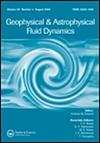双边界SQG模型的长波不稳定性
IF 1.1
4区 地球科学
Q3 ASTRONOMY & ASTROPHYSICS
Geophysical and Astrophysical Fluid Dynamics
Pub Date : 2020-10-29
DOI:10.1080/03091929.2020.1831483
引用次数: 2
摘要
研究了水平尺度远大于罗斯比变形半径的地表准地转流。提出了一种新的双边界SQG模型,将其简化为非线性偏微分方程组来描述这种流动的动力学。该系统描述了流函数的正斜压分量之间的相互作用,并推广了具有垂直速度剪切流的二维欧拉方程。从这个体系推导出了总势能和表面势能守恒定律。在这个系统的框架内,得到了斜压不稳定理论中若干问题的解,这些解与已有的解一致。结果表明,垂直剪切流是绝对不稳定的,即其不稳定性与水平速度剖面结构无关。本文还提出了一个考虑了β效应和Ekman底摩擦的广义SQG模型方程组。在此基础上研究了底部摩擦对射流的转化以及β效应对剪切流稳定性的影响。本文章由计算机程序翻译,如有差异,请以英文原文为准。
Long-wave instabilities in the SQG model with two boundaries
ABSTRACT Surface quasi-geostrophic (SQG) flows with a much larger horizontal scale than the Rossby radius of deformation are considered. A new version of the SQG model with two boundaries, which is reduced to a nonlinear system of partial differential equations, is proposed to describe the dynamics of such flows. This system describes the interaction between the barotropic and baroclinic components of the stream function and generalises the two-dimensional Euler equations for flows with a vertical velocity shear. The laws of conservation of both total and surface potential energies, which follow from this system, have been formulated. The solutions of a number of problems in the theory of baroclinic instability, which are in agreement with already known solutions, have been obtained within the framework of this system. It is shown that vertical shear flows are absolutely unstable, i.e. their instability is independent of the horizontal velocity profile structure. A generalised system of the SQG model equations, which additionally takes into account the β-effect and the Ekman bottom friction, has also been proposed. The transformation of jet flows due to the bottom friction and the influence of the β-effect on the stability of shear flows have been studied based on this system.
求助全文
通过发布文献求助,成功后即可免费获取论文全文。
去求助
来源期刊

Geophysical and Astrophysical Fluid Dynamics
地学天文-地球化学与地球物理
CiteScore
3.10
自引率
0.00%
发文量
14
审稿时长
>12 weeks
期刊介绍:
Geophysical and Astrophysical Fluid Dynamics exists for the publication of original research papers and short communications, occasional survey articles and conference reports on the fluid mechanics of the earth and planets, including oceans, atmospheres and interiors, and the fluid mechanics of the sun, stars and other astrophysical objects.
In addition, their magnetohydrodynamic behaviours are investigated. Experimental, theoretical and numerical studies of rotating, stratified and convecting fluids of general interest to geophysicists and astrophysicists appear. Properly interpreted observational results are also published.
 求助内容:
求助内容: 应助结果提醒方式:
应助结果提醒方式:


